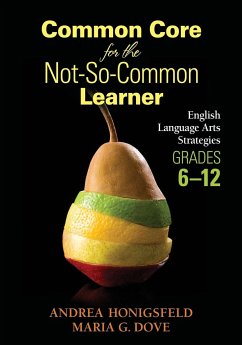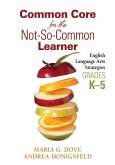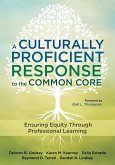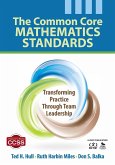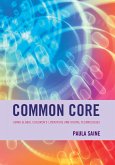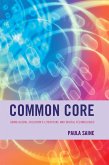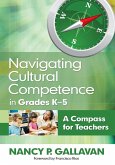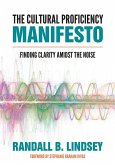Andrea Honigsfeld, Maria G. Dove
Common Core for the Not-So-Common Learner, Grades 6-12
English Language Arts Strategies
Andrea Honigsfeld, Maria G. Dove
Common Core for the Not-So-Common Learner, Grades 6-12
English Language Arts Strategies
- Broschiertes Buch
- Merkliste
- Auf die Merkliste
- Bewerten Bewerten
- Teilen
- Produkt teilen
- Produkterinnerung
- Produkterinnerung
New hope for our students who struggle most Under the best of circumstances meeting the Common Core can be a challenge. But if you're a teacher of academically and linguistically diverse students-and
Andere Kunden interessierten sich auch für
![Common Core for the Not-So-Common Learner, Grades K-5 Common Core for the Not-So-Common Learner, Grades K-5]() Maria G. DoveCommon Core for the Not-So-Common Learner, Grades K-529,99 €
Maria G. DoveCommon Core for the Not-So-Common Learner, Grades K-529,99 €![A Culturally Proficient Response to the Common Core A Culturally Proficient Response to the Common Core]() Delores B. LindseyA Culturally Proficient Response to the Common Core31,99 €
Delores B. LindseyA Culturally Proficient Response to the Common Core31,99 €![The Common Core Mathematics Standards The Common Core Mathematics Standards]() Ted H. HullThe Common Core Mathematics Standards30,99 €
Ted H. HullThe Common Core Mathematics Standards30,99 €![Common Core Common Core]() Paula SaineCommon Core52,99 €
Paula SaineCommon Core52,99 €![Common Core Common Core]() Paula SaineCommon Core98,99 €
Paula SaineCommon Core98,99 €![Navigating Cultural Competence in Grades K-5 Navigating Cultural Competence in Grades K-5]() Nancy P. GallavanNavigating Cultural Competence in Grades K-534,99 €
Nancy P. GallavanNavigating Cultural Competence in Grades K-534,99 €![The Cultural Proficiency Manifesto The Cultural Proficiency Manifesto]() Randall B. LindseyThe Cultural Proficiency Manifesto20,99 €
Randall B. LindseyThe Cultural Proficiency Manifesto20,99 €-
-
-
New hope for our students who struggle most Under the best of circumstances meeting the Common Core can be a challenge. But if you're a teacher of academically and linguistically diverse students-and
Produktdetails
- Produktdetails
- Verlag: Corwin
- Seitenzahl: 280
- Erscheinungstermin: 16. August 2013
- Englisch
- Abmessung: 254mm x 178mm x 15mm
- Gewicht: 532g
- ISBN-13: 9781452257815
- ISBN-10: 1452257817
- Artikelnr.: 37768042
- Herstellerkennzeichnung
- Libri GmbH
- Europaallee 1
- 36244 Bad Hersfeld
- gpsr@libri.de
- Verlag: Corwin
- Seitenzahl: 280
- Erscheinungstermin: 16. August 2013
- Englisch
- Abmessung: 254mm x 178mm x 15mm
- Gewicht: 532g
- ISBN-13: 9781452257815
- ISBN-10: 1452257817
- Artikelnr.: 37768042
- Herstellerkennzeichnung
- Libri GmbH
- Europaallee 1
- 36244 Bad Hersfeld
- gpsr@libri.de
Andrea Honigsfeld, EdD, is a professor in the School of Education at Molloy College, Rockville Centre, New York. Before entering the field of teacher education, she was an English-as-a-foreign-language teacher in Hungary (Grades 5-8 and adult) and an English-as-a-second-language teacher in New York City (Grades K-3 and adult). She also taught Hungarian at New York University. She was the recipient of a doctoral fellowship at St. John's University, New York, where she conducted research on individualized instruction. She has published extensively on working with multilingual learners and teacher collaboration. She received a Fulbright Award to lecture in Iceland in the fall of 2002. In the past 22 years, she has been presenting at conferences across the United States, China, Denmark, Japan, the Philippines, Sweden, Thailand, the United Kingdom, and the United Arab Emirates. She coauthored Differentiated Instruction for At-Risk Students (2009) and coedited the five-volume Breaking the Mold of Education series (2010-2013), published by Rowman and Littlefield. She is also the coauthor of Core Instructional Routines: Go-To Structures for Effective Literacy Teaching, K-5 and 6-12 (2014), Growing Language and Literacy (K-8 and 6-12, 2019, 2024 respectively) published by Heinemann. With Maria G. Dove, she coedited Coteaching and Other Collaborative Practices in the EFL/ESL Classroom: Rationale, Research, Reflections, and Recommendations (2012), Co-teaching for English Learners: Evidence-based Practices and Research-informed Outcomes (2020), Portraits of collaboration: Educators working together to support multilingual learners (2022), and coauthored Collaboration and Co-Teaching: Strategies for English Learners (2010), Common Core for the Not-So-Common Learner, Grades K-5: English Language Arts Strategies (2013), Common Core for the Not-So-Common Learner, Grades 6-12: English Language Arts Strategies (2013), Beyond Core Expectations: A Schoolwide Framework for Serving the Not-So-Common Learner (2014), Collaboration and Co-Teaching: A Leader's Guide (2015), Co-Teaching for English Learners: A Guide to Collaborative Planning, Instruction, Assessment, and Reflection (2018), Collaborating for English Learners: A Foundational Guide to Integrated Practices (2019), and Co-Planning: 5 Essential Practices to Integrate Curriculum and Instruction for English Learners (2022). She is a contributing author of Breaking Down the Wall: Essential Shifts for English Learner Success (2020), From Equity Insights to Action (2021), Digital-Age Teaching for English Learners (2022), Collaboration and Co-teaching for D ual Language Learners: Transforming Programs for Multilingualism and E quity (2023), Breaking Down the Monolingual Wall: Essential Shifts for Multilingual Learners' Success (2024). Collaboration for Multilingual Learners with Exceptionalities: We Share the Students (2024), Collaborative Assessment for Multilingual Learners and Teachers: Pathways to Partnerships (2025), 9 Dimensions of Scaffolding for Multilingual Learners. Ten of her Corwin books are bestsellers.
Chapter 1. Introduction
Who Are Our Not So Common Learners?
The Standards Movement
Common Core Advances
Application of the Common Core to Address Individual Differences
Student Diversity and Teacher Challenges
What Is Not Covered In The Common Core Document
Focus on Research-Based Strategies to Address Learning Needs
Chapter 2. Strategies for Academic Language Development
Why Diverse Adolescent Learners Need Explicit Instruction in Academic
Language?
Core Language and Vocabulary Strategies
Conventions of Standard English
Knowledge and Application of Language
Vocabulary Acquisition and Use
Anticipated Outcomes
Instructional Challenges
Promising Classroom Practices
Common Core Standards-(Un)Common Reflection Questions
Key Resources
Chapter 3. Reading Strategies for Literature
Why Teaching Diverse Adolescent Learners Reading Strategies Promotes
Comprehension of Literary Texts
Core Reading Strategies
Key Ideas and Details
Craft and Structure
Integration of Knowledge and Ideas
Range of Reading and Level of Text Complexity
Anticipated Outcomes
Instructional Challenges
Promising Classroom Practices
Common Core Standards-(Un)Common Reflection Questions
Key Resources
Chapter 4. Reading Strategies for Informational Texts
Why Teaching Diverse Adolescent Learners Reading Strategies Promotes
Comprehension of Informational Texts
Core Informational Reading Strategies
Key Ideas and Details
Craft and Structure
Integration of Knowledge and Ideas
Range of Reading and Level of Text Complexity
Anticipated Outcomes
Instructional Challenges
Promising Classroom Practices
Common Core Standards-(Un)Common Reflection Questions
Key Resources
Chapter 5. Writing Strategies
Why Scaffolding and Explicit Skills Instruction Improves the Writing of
Diverse Adolescent Learners
Core Writing Strategies
Text Types and Purposes
Production and Distribution of Writing
Research to Build and Present Knowledge
Range of Writing
Anticipated Outcomes
Instructional Challenges
Promising Classroom Practices
Common Core Standards-(Un)Common Reflection Questions
Key Resources
Chapter 6. Speaking and Listening Strategies
Why Speaking and Listening Skills Improve the Overall Academic Development
of Diverse Adolescent Learners
Core Speaking and Listening Strategies
Comprehension and Collaboration
Presentation of Knowledge and Ideas
Anticipated Outcomes
Instructional Challenges
Promising Classroom Practices
Common Core Standards-(Un)Common Reflection Questions
Key Resources
Chapter 7. Key to Successful Implementation: Collaborative Strategies
Why Collaborative Practices Help Meet the Common Core
Core Collaborative Practices
Instructional
Curriculum mapping and alignment
Joint instructional planning
Parallel teaching
Co-developing instructional materials
Collaborative assessment
Co-teaching
Noninstructional
Joint professional development
Teacher research
Joint parent-teacher conferences and report card writing
Planning, facilitating, and participating in extracurricular activities
Anticipated Outcomes
Challenges
Common Core Collaborations-(Un)Common Reflection Questions
Key Resources
Who Are Our Not So Common Learners?
The Standards Movement
Common Core Advances
Application of the Common Core to Address Individual Differences
Student Diversity and Teacher Challenges
What Is Not Covered In The Common Core Document
Focus on Research-Based Strategies to Address Learning Needs
Chapter 2. Strategies for Academic Language Development
Why Diverse Adolescent Learners Need Explicit Instruction in Academic
Language?
Core Language and Vocabulary Strategies
Conventions of Standard English
Knowledge and Application of Language
Vocabulary Acquisition and Use
Anticipated Outcomes
Instructional Challenges
Promising Classroom Practices
Common Core Standards-(Un)Common Reflection Questions
Key Resources
Chapter 3. Reading Strategies for Literature
Why Teaching Diverse Adolescent Learners Reading Strategies Promotes
Comprehension of Literary Texts
Core Reading Strategies
Key Ideas and Details
Craft and Structure
Integration of Knowledge and Ideas
Range of Reading and Level of Text Complexity
Anticipated Outcomes
Instructional Challenges
Promising Classroom Practices
Common Core Standards-(Un)Common Reflection Questions
Key Resources
Chapter 4. Reading Strategies for Informational Texts
Why Teaching Diverse Adolescent Learners Reading Strategies Promotes
Comprehension of Informational Texts
Core Informational Reading Strategies
Key Ideas and Details
Craft and Structure
Integration of Knowledge and Ideas
Range of Reading and Level of Text Complexity
Anticipated Outcomes
Instructional Challenges
Promising Classroom Practices
Common Core Standards-(Un)Common Reflection Questions
Key Resources
Chapter 5. Writing Strategies
Why Scaffolding and Explicit Skills Instruction Improves the Writing of
Diverse Adolescent Learners
Core Writing Strategies
Text Types and Purposes
Production and Distribution of Writing
Research to Build and Present Knowledge
Range of Writing
Anticipated Outcomes
Instructional Challenges
Promising Classroom Practices
Common Core Standards-(Un)Common Reflection Questions
Key Resources
Chapter 6. Speaking and Listening Strategies
Why Speaking and Listening Skills Improve the Overall Academic Development
of Diverse Adolescent Learners
Core Speaking and Listening Strategies
Comprehension and Collaboration
Presentation of Knowledge and Ideas
Anticipated Outcomes
Instructional Challenges
Promising Classroom Practices
Common Core Standards-(Un)Common Reflection Questions
Key Resources
Chapter 7. Key to Successful Implementation: Collaborative Strategies
Why Collaborative Practices Help Meet the Common Core
Core Collaborative Practices
Instructional
Curriculum mapping and alignment
Joint instructional planning
Parallel teaching
Co-developing instructional materials
Collaborative assessment
Co-teaching
Noninstructional
Joint professional development
Teacher research
Joint parent-teacher conferences and report card writing
Planning, facilitating, and participating in extracurricular activities
Anticipated Outcomes
Challenges
Common Core Collaborations-(Un)Common Reflection Questions
Key Resources
Chapter 1. Introduction
Who Are Our Not So Common Learners?
The Standards Movement
Common Core Advances
Application of the Common Core to Address Individual Differences
Student Diversity and Teacher Challenges
What Is Not Covered In The Common Core Document
Focus on Research-Based Strategies to Address Learning Needs
Chapter 2. Strategies for Academic Language Development
Why Diverse Adolescent Learners Need Explicit Instruction in Academic
Language?
Core Language and Vocabulary Strategies
Conventions of Standard English
Knowledge and Application of Language
Vocabulary Acquisition and Use
Anticipated Outcomes
Instructional Challenges
Promising Classroom Practices
Common Core Standards-(Un)Common Reflection Questions
Key Resources
Chapter 3. Reading Strategies for Literature
Why Teaching Diverse Adolescent Learners Reading Strategies Promotes
Comprehension of Literary Texts
Core Reading Strategies
Key Ideas and Details
Craft and Structure
Integration of Knowledge and Ideas
Range of Reading and Level of Text Complexity
Anticipated Outcomes
Instructional Challenges
Promising Classroom Practices
Common Core Standards-(Un)Common Reflection Questions
Key Resources
Chapter 4. Reading Strategies for Informational Texts
Why Teaching Diverse Adolescent Learners Reading Strategies Promotes
Comprehension of Informational Texts
Core Informational Reading Strategies
Key Ideas and Details
Craft and Structure
Integration of Knowledge and Ideas
Range of Reading and Level of Text Complexity
Anticipated Outcomes
Instructional Challenges
Promising Classroom Practices
Common Core Standards-(Un)Common Reflection Questions
Key Resources
Chapter 5. Writing Strategies
Why Scaffolding and Explicit Skills Instruction Improves the Writing of
Diverse Adolescent Learners
Core Writing Strategies
Text Types and Purposes
Production and Distribution of Writing
Research to Build and Present Knowledge
Range of Writing
Anticipated Outcomes
Instructional Challenges
Promising Classroom Practices
Common Core Standards-(Un)Common Reflection Questions
Key Resources
Chapter 6. Speaking and Listening Strategies
Why Speaking and Listening Skills Improve the Overall Academic Development
of Diverse Adolescent Learners
Core Speaking and Listening Strategies
Comprehension and Collaboration
Presentation of Knowledge and Ideas
Anticipated Outcomes
Instructional Challenges
Promising Classroom Practices
Common Core Standards-(Un)Common Reflection Questions
Key Resources
Chapter 7. Key to Successful Implementation: Collaborative Strategies
Why Collaborative Practices Help Meet the Common Core
Core Collaborative Practices
Instructional
Curriculum mapping and alignment
Joint instructional planning
Parallel teaching
Co-developing instructional materials
Collaborative assessment
Co-teaching
Noninstructional
Joint professional development
Teacher research
Joint parent-teacher conferences and report card writing
Planning, facilitating, and participating in extracurricular activities
Anticipated Outcomes
Challenges
Common Core Collaborations-(Un)Common Reflection Questions
Key Resources
Who Are Our Not So Common Learners?
The Standards Movement
Common Core Advances
Application of the Common Core to Address Individual Differences
Student Diversity and Teacher Challenges
What Is Not Covered In The Common Core Document
Focus on Research-Based Strategies to Address Learning Needs
Chapter 2. Strategies for Academic Language Development
Why Diverse Adolescent Learners Need Explicit Instruction in Academic
Language?
Core Language and Vocabulary Strategies
Conventions of Standard English
Knowledge and Application of Language
Vocabulary Acquisition and Use
Anticipated Outcomes
Instructional Challenges
Promising Classroom Practices
Common Core Standards-(Un)Common Reflection Questions
Key Resources
Chapter 3. Reading Strategies for Literature
Why Teaching Diverse Adolescent Learners Reading Strategies Promotes
Comprehension of Literary Texts
Core Reading Strategies
Key Ideas and Details
Craft and Structure
Integration of Knowledge and Ideas
Range of Reading and Level of Text Complexity
Anticipated Outcomes
Instructional Challenges
Promising Classroom Practices
Common Core Standards-(Un)Common Reflection Questions
Key Resources
Chapter 4. Reading Strategies for Informational Texts
Why Teaching Diverse Adolescent Learners Reading Strategies Promotes
Comprehension of Informational Texts
Core Informational Reading Strategies
Key Ideas and Details
Craft and Structure
Integration of Knowledge and Ideas
Range of Reading and Level of Text Complexity
Anticipated Outcomes
Instructional Challenges
Promising Classroom Practices
Common Core Standards-(Un)Common Reflection Questions
Key Resources
Chapter 5. Writing Strategies
Why Scaffolding and Explicit Skills Instruction Improves the Writing of
Diverse Adolescent Learners
Core Writing Strategies
Text Types and Purposes
Production and Distribution of Writing
Research to Build and Present Knowledge
Range of Writing
Anticipated Outcomes
Instructional Challenges
Promising Classroom Practices
Common Core Standards-(Un)Common Reflection Questions
Key Resources
Chapter 6. Speaking and Listening Strategies
Why Speaking and Listening Skills Improve the Overall Academic Development
of Diverse Adolescent Learners
Core Speaking and Listening Strategies
Comprehension and Collaboration
Presentation of Knowledge and Ideas
Anticipated Outcomes
Instructional Challenges
Promising Classroom Practices
Common Core Standards-(Un)Common Reflection Questions
Key Resources
Chapter 7. Key to Successful Implementation: Collaborative Strategies
Why Collaborative Practices Help Meet the Common Core
Core Collaborative Practices
Instructional
Curriculum mapping and alignment
Joint instructional planning
Parallel teaching
Co-developing instructional materials
Collaborative assessment
Co-teaching
Noninstructional
Joint professional development
Teacher research
Joint parent-teacher conferences and report card writing
Planning, facilitating, and participating in extracurricular activities
Anticipated Outcomes
Challenges
Common Core Collaborations-(Un)Common Reflection Questions
Key Resources

